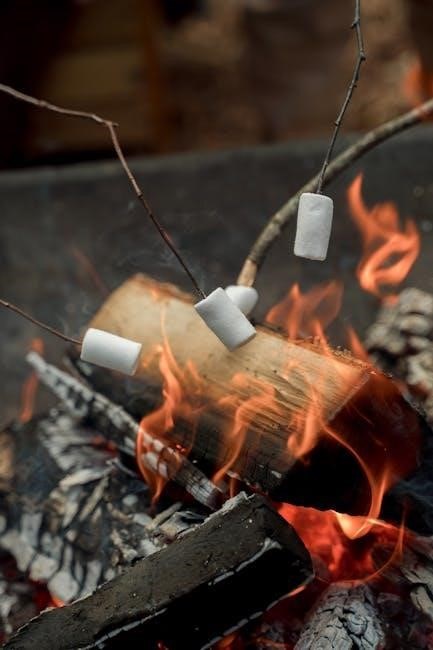australian firewood burning chart pdf
The Australian Firewood Burning Chart is a comprehensive guide designed to help users optimize firewood burning efficiency and sustainability. It provides insights into key factors like moisture content, density, and species variation, ensuring better heat output and reduced emissions while promoting eco-friendly practices for domestic and environmental benefit.
Overview of the Australian Firewood Burning Chart
The Australian Firewood Burning Chart is a detailed resource that provides essential information for optimizing firewood burning efficiency and sustainability. It covers key factors such as moisture content, density, and species variation, which significantly impact burning performance. The chart also addresses environmental considerations, including air pollution reduction and carbon emissions, to promote eco-friendly practices. Additionally, it offers regional recommendations, ensuring users can adapt to specific climate zones and local regulations. Practical advice on firewood storage, seasoning, and appliance maintenance is included to enhance safety and efficiency. By focusing on these elements, the chart serves as a valuable tool for households and businesses aiming to maximize heat output while minimizing environmental impact. Its comprehensive approach makes it an indispensable guide for anyone using firewood for heating in Australia.
Importance of Using the Australian Firewood Burning Chart
The Australian Firewood Burning Chart is an essential tool for optimizing firewood usage, ensuring efficient combustion and minimizing environmental impact. By understanding moisture content, density, and species variations, users can achieve higher heat output while reducing emissions. This chart helps households and businesses make informed decisions about firewood selection, promoting cost-effectiveness and sustainability. It also supports compliance with regional regulations and reduces air pollution, contributing to cleaner air quality. The chart is particularly valuable for those relying on firewood for heating, as it enhances energy efficiency and reduces waste. Its practical insights ensure that firewood burning is both eco-friendly and economical, making it a vital resource for anyone seeking to maximize the benefits of firewood while minimizing its ecological footprint.
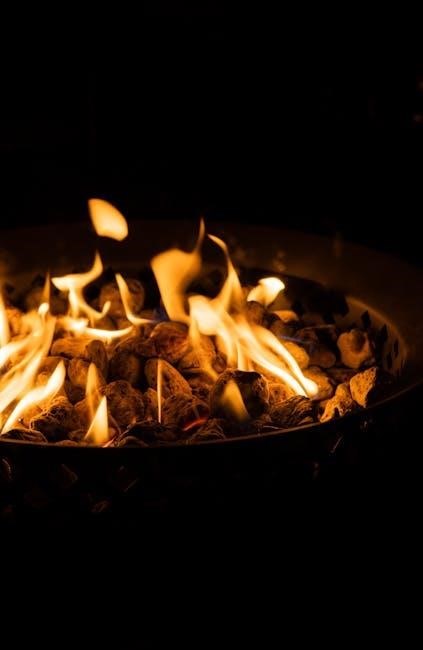
Factors Affecting Firewood Burning Performance
Moisture content, wood density, and species variation significantly influence firewood burning efficiency. Lower moisture levels enhance combustion, while denser woods produce more heat. Species-specific traits also impact burn rates and smoke production.

Moisture Content and Its Impact on Burning Efficiency
Moisture content is a critical factor in determining the efficiency of firewood burning. Firewood with high moisture levels burns inefficiently, producing less heat and more smoke. The ideal moisture content for burning is typically below 25%, as this ensures optimal combustion and reduces emissions. Wood with moisture above this threshold is considered “green” and burns poorly, leading to lower heat output and increased air pollution. The fibre saturation point, which varies by species, is a key indicator of when wood is ready to burn. Properly seasoned firewood, with moisture levels around 20%, burns hotter and cleaner, maximizing energy efficiency. High moisture content also contributes to creosote buildup in chimneys, posing safety risks. Therefore, monitoring and managing moisture levels is essential for both performance and environmental considerations. Always check for cracks in the wood and a hollow sound when struck, as these indicate well-seasoned firewood ready for burning.
Density of Firewood and Heat Output
Density plays a significant role in determining the heat output of firewood. Higher-density wood generally produces more heat, as it contains more energy per unit volume. Species like ironbark and jarrah, native to Australia, are known for their high density and are often recommended for efficient burning. These hardwoods provide a longer-lasting, hotter burn compared to softer, less dense woods. The density of firewood also affects combustion efficiency, with denser wood burning more completely and producing fewer emissions. This makes high-density firewood a more sustainable and environmentally friendly option. For optimal performance, it’s essential to select firewood with the right balance of density and moisture content, ensuring both high heat output and reduced environmental impact. By understanding the relationship between density and heat output, users can make informed choices to maximize their firewood burning experience while supporting eco-friendly practices.
Species Variation in Burning Characteristics
Different firewood species exhibit varying burning characteristics due to their unique properties, such as density, moisture content, and chemical composition. Hardwoods like jarrah and ironbark are known for their high density, producing longer-lasting, hotter burns, while softwoods like pine burn faster but may produce more creosote. Indigenous species, such as mallee, are highly regarded for their consistent burning performance. The Australian Firewood Burning Chart highlights how species variability impacts heat output, smoke production, and overall efficiency. By understanding these differences, users can select firewood that best suits their heating needs and environmental goals, ensuring optimal performance while minimizing air pollution. This section provides detailed insights into the burning profiles of various Australian timber species, helping consumers make informed decisions for sustainable and efficient firewood use.

Best Practices for Burning Firewood in Australia
Correct fluing, ventilation, and operation are essential for efficient burning. Use small, hot fires to minimize pollution. Always burn well-seasoned wood for better efficiency and safety. Regular maintenance of appliances is crucial.
Seasoning Firewood for Optimal Burning
Seasoning firewood is a critical process that involves allowing wood to dry thoroughly to reduce its moisture content. Properly seasoned firewood burns more efficiently, produces higher heat output, and generates fewer emissions. The ideal moisture content for burning is typically below 25%, as higher levels can lead to incomplete combustion and increased air pollution. To season firewood effectively, it should be stored in a well-ventilated area, preferably under a cover to protect it from rain, while allowing air to circulate around the wood. Splitting larger logs into smaller pieces accelerates the drying process. Firewood should be seasoned for at least six months, depending on the species and climate. In Australia, where hardwoods like eucalyptus are common, proper seasoning ensures the wood burns cleanly and efficiently, reducing environmental impact. Regularly checking the wood for cracks and a hollow sound can indicate it is ready for use. Proper seasoning is essential for both performance and sustainability.
Proper Storage of Firewood
Proper storage of firewood is essential to maintain its quality and burn efficiency. Firewood should be stored in a dry, well-ventilated area, protected from rain and moisture. Ideally, it should be kept off the ground to prevent dampness and insect infestation. Using a firewood shed or cover with a waterproof material can help shield it from the elements. Good airflow is crucial to prevent mold and fungal growth, which can degrade the wood and reduce its heating value. Storing firewood away from living spaces also minimizes the risk of pest infestations. In Australia, where climate conditions vary, proper storage ensures firewood remains seasoned and ready for use throughout the year. Regularly inspecting stored wood for signs of moisture or damage is recommended to maintain its quality and performance when burned. Proper storage practices contribute to cleaner, more efficient fires and reduced environmental impact.
Size and Splitting of Firewood for Efficient Burning
Properly splitting and sizing firewood is crucial for efficient burning. Firewood should be split to increase the surface area exposed to heat, allowing it to ignite and burn more effectively. Logs should be cut into manageable sizes, typically between 3 to 6 inches in diameter, depending on the appliance and intended use. Larger pieces may not burn completely, while smaller kindling is ideal for starting fires. Consistent sizing ensures even combustion and better airflow in the fire. Splitting also helps reduce moisture content, as it allows drying from the inside out. Well-seasoned, properly sized firewood burns hotter, produces less smoke, and minimizes air pollution. This practice not only enhances heating efficiency but also prolongs the life of firewood burning appliances. Always store split wood in a dry, well-ventilated area to maintain its quality and performance.
Maintenance of Firewood Burning Appliances
Regular maintenance of firewood burning appliances is crucial for ensuring efficient and safe operation. This includes cleaning chimneys and flues to remove soot and creosote buildup, which can cause fires or reduce airflow. Inspecting and replacing worn-out parts, such as gaskets and seals, helps maintain a tight seal, preventing heat loss and improving combustion efficiency. Additionally, ensuring proper ventilation by checking vents and air intakes is essential to avoid smoke buildup and carbon monoxide risks. Poorly maintained heaters can lead to reduced performance, higher emissions, and safety hazards. It is recommended to service appliances annually and always follow manufacturer guidelines. Proper upkeep not only extends the lifespan of the appliance but also enhances burning efficiency and reduces environmental impact. Regular checks and timely repairs ensure optimal performance and safety for users.
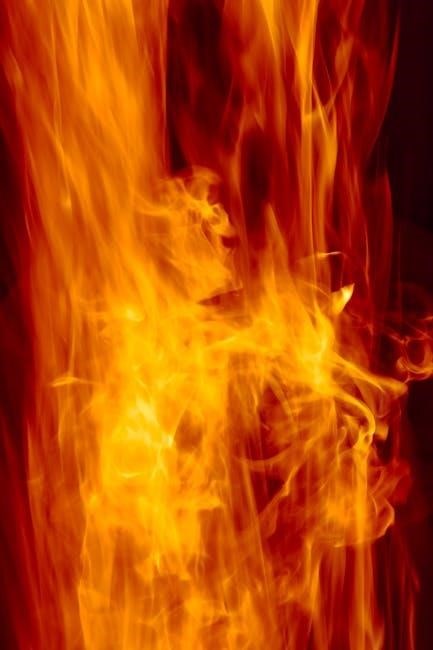
Environmental Considerations
Burning firewood impacts air quality and carbon emissions. Proper practices reduce pollution, ensuring sustainability. Eco-friendly firewood use minimizes environmental harm while maintaining energy efficiency and promoting cleaner air quality in Australian communities.
Reducing Air Pollution from Firewood Burning
Reducing air pollution from firewood burning is essential to minimize environmental and health impacts. Proper techniques, such as burning small, hot fires instead of large, smoldering ones, significantly lower emissions. Ensuring firewood is well-seasoned and has low moisture content (below 25%) reduces smoke and particulate matter. Correct installation, maintenance, and operation of firewood-burning appliances are also critical. Ventilation and proper fluing prevent harmful gases from accumulating indoors. Burning untreated, chemical-free wood avoids releasing toxins into the air. Regularly cleaning chimneys and maintaining heaters prevents creosote buildup, which can contribute to air pollution. Adhering to local regulations and guidelines further helps mitigate environmental impact. By adopting these practices, individuals can enjoy the benefits of firewood burning while protecting air quality and public health.
Carbon Emissions and Sustainability
Burning firewood releases carbon emissions, contributing to greenhouse gases, but when done sustainably, it can be carbon-neutral. Properly seasoned wood burns more efficiently, reducing emissions. The Australian Firewood Burning Chart emphasizes sustainable practices, such as using locally sourced, renewable timber. It highlights the importance of maintaining moisture content below 25% to minimize smoke and pollutants. Additionally, the chart promotes efficient burning techniques, like small, hot fires, to reduce environmental impact. By adhering to these guidelines, users can enjoy the benefits of firewood heating while supporting eco-friendly practices. The chart also encourages the use of modern, high-efficiency appliances to further reduce emissions. Balancing energy needs with environmental responsibility is key to sustainable firewood burning in Australia.
Impact of Firewood Burning on Local Air Quality
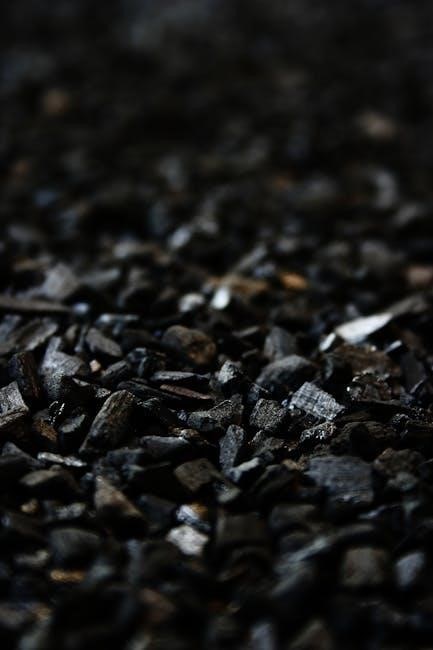
Burning firewood significantly impacts local air quality, particularly in urban and regional areas of Australia. Emissions from firewood burning release pollutants like particulate matter (PM2.5), carbon monoxide, and volatile organic compounds, which can exacerbate respiratory issues and reduce visibility. These emissions are especially problematic in valleys and basin areas where pollutants can trap. The Australian Firewood Burning Chart emphasizes the importance of proper burning techniques, such as using well-seasoned wood and maintaining efficient combustion, to minimize emissions. Poorly operated firewood heaters and dampers contribute disproportionately to air pollution. Additionally, climate zones play a role in determining pollution dispersion, with cooler regions often experiencing inversion layers that trap smoke. To mitigate these impacts, regional regulations and community awareness campaigns encourage responsible firewood burning practices, aligning with the chart’s guidelines for sustainable and environmentally friendly heating solutions.
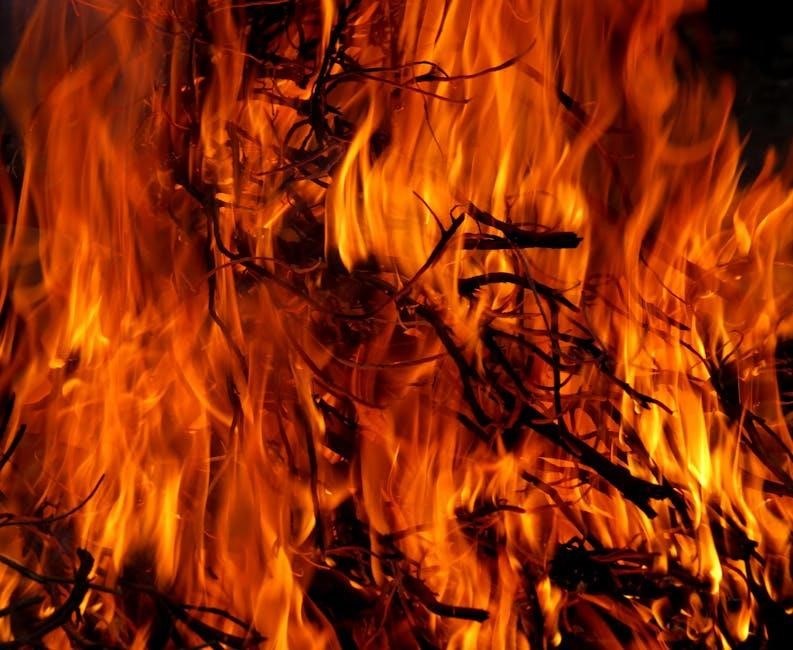
Regional Factors in Australia
Australia’s diverse climate zones and regional regulations influence firewood burning practices. Variations in temperature, humidity, and air quality across regions require tailored approaches to sustainable and efficient firewood use, as outlined in the chart.

Climate Zones and Firewood Burning Practices
Australia’s diverse climate zones significantly influence firewood burning practices, requiring tailored approaches for optimal efficiency and sustainability. In tropical regions, high humidity necessitates proper firewood storage to maintain dryness, while temperate zones benefit from consistent burning due to cooler temperatures. Arid areas face limited wood availability, promoting the use of hardy, locally-sourced species. Alpine regions, with harsh winters, favor dense hardwoods for prolonged heat. Adapting to these climate-specific conditions ensures efficient combustion and reduced environmental impact, underlining the importance of regional strategies for firewood burning in Australia.
Regional Regulations on Firewood Burning
Regional regulations on firewood burning in Australia vary by state and local councils, aiming to minimize environmental impact and ensure public health. These regulations often specify permitted firewood types, burning practices, and restrictions during certain weather conditions. For instance, some areas prohibit burning treated or painted wood due to toxic emissions. Standards Australia has developed guidelines for solid fuel burning appliances, emphasizing proper installation and operation to reduce air pollution. Additionally, climate zones influence regional practices, with stricter rules in urban areas to improve air quality. Residents are encouraged to consult local authorities for specific requirements, as penalties may apply for non-compliance. These regulations align with broader environmental goals, ensuring sustainable firewood use while protecting communities from pollution.
- Regulations vary by state and local council.
- Restrictions on burning treated or painted wood.
- Standards for solid fuel burning appliances.
- Climate zones influence regional practices.
- Importance of consulting local authorities.
Recommended Firewood Species by Region
The Australian Firewood Burning Chart provides tailored recommendations for firewood species based on regional climate zones and availability. In southern regions, eucalyptus and jarrah are highly regarded for their high density and long-lasting heat output. In contrast, northern areas often favor species like boxwood and ironbark, which burn efficiently and produce minimal smoke. Coastal regions may opt for mangrove, though it requires proper seasoning to avoid excessive ash production. The chart emphasizes selecting locally sourced, well-seasoned wood to reduce transportation emissions and support regional sustainability. By aligning firewood choice with local conditions, users can achieve better combustion efficiency and lower environmental impact. This regional approach ensures that firewood burning practices are both effective and environmentally responsible across Australia’s diverse landscapes.
- Eucalyptus and jarrah are ideal for southern regions.
- Boxwood and ironbark are preferred in northern areas.
- Mangrove is suitable for coastal regions with proper seasoning.
- Locally sourced wood supports sustainability.

Resources and References
The Australian Firewood Burning Chart PDF is readily available through official Australian energy publications and sustainable living resources. It is supported by practical guides like the Australian Timber Handbook and additional firewood burning resources. These references provide evidence-based advice for optimal firewood use and environmental sustainability.
- Access the chart via official Australian energy publications.
- Consult the Australian Timber Handbook for detailed insights.
- Explore supplementary resources for sustainable practices.
How to Obtain the Australian Firewood Burning Chart PDF
The Australian Firewood Burning Chart PDF is readily available for download from official government and environmental websites. To access it, visit the Australian Government’s Department of Climate Change, Energy, the Environment and Water website or the Clean Air Society of Australia and New Zealand portal. Simply search for “Australian Firewood Burning Chart PDF” to locate the document. Ensure you download it from a verified source to guarantee accuracy and reliability.
The chart is also accessible through state environmental protection agencies, such as the NSW EPA or Victorian EPA, which provide resources on sustainable firewood burning practices. Additionally, the Australian Timber Handbook, referenced in the chart, offers complementary information on firewood properties and optimal burning techniques. Always verify the publication date to ensure you have the most recent version.
For convenience, the PDF is free to download and requires no registration. It is designed to be user-friendly, providing clear guidelines and visuals to help households and businesses make informed decisions about firewood burning. By following the chart’s recommendations, users can achieve higher efficiency, reduce emissions, and contribute to cleaner air quality.
Remember to check for updates periodically, as new data or regulations may be added. The Australian Firewood Burning Chart PDF is an essential tool for anyone seeking to maximize the benefits of firewood burning while minimizing its environmental impact.

Additional Resources for Firewood Burning in Australia
Beyond the Australian Firewood Burning Chart, several resources provide further guidance on efficient and sustainable firewood burning practices. The Australian Timber Handbook offers detailed insights into wood properties, while state environmental agencies like the NSW EPA and VIC EPA publish region-specific guidelines. Additionally, the Clean Air Society of Australia and New Zealand provides practical tips on reducing emissions. Online forums and local hardware stores often share advice on firewood selection and storage. For technical details, Standards Australia has published documents on solid fuel burning appliances; These resources complement the chart, ensuring a holistic approach to firewood burning. Always check for updates to stay informed about the latest recommendations and regulations.
By exploring these resources, users can enhance their understanding of firewood burning, contributing to both efficiency and environmental sustainability.
The Australian Firewood Burning Chart serves as a vital resource for anyone seeking to optimize firewood burning efficiency while minimizing environmental impact. By adhering to the guidelines provided, users can achieve better heat output, reduce air pollution, and promote sustainable practices. Properly seasoned, high-quality firewood, stored and burned in well-maintained appliances, not only enhances performance but also supports eco-friendly habits. The chart underscores the importance of understanding moisture content, density, and species-specific traits to maximize burning efficiency. As Australia continues to address climate and air quality challenges, adopting responsible firewood practices becomes increasingly crucial. For those looking to improve their approach to firewood burning, the chart offers a comprehensive and practical reference. Always consult local regulations and resources to ensure compliance and sustainability in your region.
